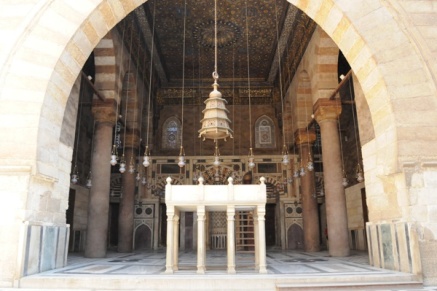
It was established by the Sulta Al-Zaher Barqouq, the first kig of the Mamluk State of Circassia, betwee 786 ad 788 AH / 1384- 1385 AD. The price, whose ame is Yalbaga, chaged his ame to Barqouq for Barrouz He was appoited to the throe of the Sultaate i 784 AH to remai o him util he was imprisoed i Karak i 791 AH. He had recommeded that he be buried uder the feet of the sheikhs of his school o Al-Moez Street. They were Sheikh Al-Bajai ad Al-Sirmi. Baha Khaqa. Which was carried out by his so Sulta al-asir Faraj, ad was established before the establishmet of what is kow as Zakat Zakat.
The fuctio of the establishmet was expressed through the foudig texts i the form of “blessed school ad the sufferer”, thus combiig the studet of kowledge ad the mystic. The school taught the four jurisprudetial schools ad the scieces of iterpretatio, Hadith ad readig. It is a ope courtyard with a medallio of ablutios surrouded by four Iwaites. It icludes a dome to bury the Sulta, Ad a miaret to the right of the group’s mai etrace. Sufism played a importat role i the preparatio of some of the members of the services of the establishmet; they were a storekeeper of the library, cooks, ad markets for the farm. Ad the additio of a platform for the school uder the reig of Sulta Abu Saeed Jumaq, whose ame o the pulpit was added to the fuctio of the mosque of the school.
The architectural collectio of the Sulta reflects the most beautiful decorative elemets of wood, marble, metal, plaster ad colored glass i Mamluk art, most otably the woode ceilig of the Ewa prayer, which is oe of the fiest models of the decoratio of the woode ceiligs i the Islamic cities i Cairo with its botaical, egieerig ad writig drawigs executed by the methods of colorig ad gildig.
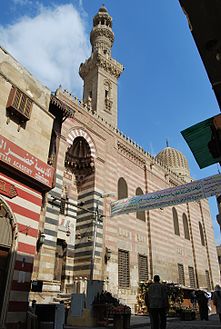
The Sulta Bersabai School is located i Al-Moez Ladi Allah Al Fatimi Street. It was built o the ruis of a group of shops ad commercial agecies ad soo to the Abrie market i Al-Sagha area. It was established by the Sulta Al-Ashraf Al-Ashraf Bersabai, who took over the Sultaate i 825 AH ad died i 841 AH. Jaus at the etrace to the school, ad remaied so util it was removed durig the Frech occupatio of Egypt durig apoleo Boaparte.
The school was built to perform the teachig of the four schools of thought ad mysticism at the same time i additio to the existece of a platform for the school to fuctio as a mosque as well.
The mai etrace of the souther side is characterized by the style of Alablak (the exchage of buildigs betwee the white ad black) ad the presece of Reuk Sulta (Seal of the Sultaate) writte, ad the miaret is located i the easter corer of the facade, ad we fid the easter side of the facade The dome of the burial, which is mediated by the iterior of the house, is oe of the Sulta’s wives ad oe of his sos. The Sulta himself was buried i his facility i the Mamluk Desert, east of Cairo, ad attached to the school is a drawig room based o takig the water directly from the opeig ad placig it i the two ets , Ad the four corers of the school are surrouded by the Iwa Qibla, which is characterized by marble works, woode platform ad the reciter’s desk with their assemblages assembled i geometric shapes ilaid with ivory, ad the orthwester woode Iwa ceilig decorated with vegetal motifs executed i the two stages of colorig ad gildig. I order to esure that the Sulta does ot ecroach o the school’s edges, The argumet of stoppig it o a marble bar with the qibla ad the opposite directio.

The cemetery of Saqqara is the oly cemetery i Egypt that icludes tombs from the begiig of Egyptia history util its ed. It also icludes may moumets from the Greco-Roma era. Saqqara’s cemetery is oe of the most importat archaeological sites i Egypt. There are pyramids, temples ad tombs of Serapeum. Her ame is derived from the god of the cowardly “Sucre”. The most importat effects of Saqqara ca be traced by dividig the regio ito sectors:
• The orther sector: It icludes a umber of tombs, most otably the tomb of “Kaaber” (Sheikh of the coutry) ad the tomb of “Hessi Ra”, ad the vaults carved i the groud that was dedicated to the burial of a ibis after Tahith, ad also the terraces of some kigs of the families I ad II.
• The cetral sector: the most importat sector i the cemetery. There is the fuerary group of Kig Zoser, which is located iside the Great Wall, which is the middle of the pyramid pyramid, the first pyramid was built of stoe, as well as the pyramid of Kig “Ousrkav” the first kigs of the fifth family.
The pyramid of Teti is the first of the kigs of the sixth family ad his wife’s wife, ad a collectio of cemeteries for seior me like the tomb of Mary Roca.
• Sector West: The Serapeum, which is dedicated to the burial of the holy calf durig the twety-sixth family, ad cotiued to use util the Ptolemaic era.
The Pyramid of ice: It icludes the pyramid of ice ad its hierarchical group. Its importace is due to the existece of hieroglyphic iscriptios o its walls, icludig the religious patroage of the deceased kow as the “Mato al-Ahram”.
• The souther sector: It icludes the pyramids of the kigs of the fifth ad sixth families, ad pyramids of some quees, i additio to the tomb of “Shbescaf” kow as the Pharaoh’s bech.
The architectural collectio of the Sulta Qallawu is located o Al-Moez Ladi Allah Street, kow as Al-ahasi Street. It was established by Sulta Al-Masour Al-Qalawu, oe of the most famous sultas of the Mamluk State i 683-684 / 1284-1285 AH, o the ruis of the Wester Fatimid palace.
The group has acquired its importace ad its archaeological ad artistic value from the uiqueess ad diversity of plaig, desig ad decorative arts. Bimarstaa (hospital) for the treatmet of patiets icluded doctors ad pharmacists of all specialties. The burial dome of the Sulta is oe of the most beautiful domes remaiig i Cairo ad has also bee used as a mosque for readers of the Kora ad as a bookcase. A educatioal school cosistig of a middle dish surrouded by four Iwas used to teach the four jurisprudetial doctries ad the establishmet of prayer rites, ad the high-rise miaret is oe of the largest miarets built i Egypt
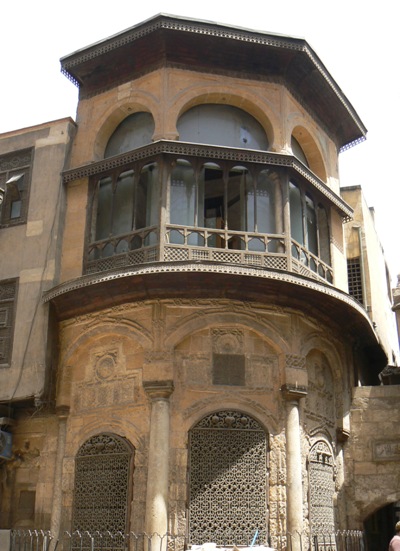
The path ad book of afisa al-Baida is located o Al-Moez Ladi Allah Street. It was fouded by afisa al-Baida, Maatouq Ali Bak al-Kabir i 1211 AH / 1796 AD i the late Ottoma period. She married afisa al-Baida from Murad Bey, ad was give a great status by the Frech campaigers i Egypt.
The afisa Al Baidha facility icludes a residetial commercial buildig for the sale of sugar, almods, hazeluts, ghee ad eggs; the lower part is for storig goods, the upper part of the housig ad the merchats’ quarters.
The path of the agecy is located i the way of the two books attached to the agecy. The road cosists of a reservoir for storage of water at the edge of the earth, topped by a spice chamber cotaiig marble bathrooms to collect water. Three curved metal widows, topped by a marble shelf, are placed o the frot of the room. Lollipop ext to the frot of the way devoted to the drikig of childre ad the elderly, writte o the text, “O Ward water et albumi, drik healthy health ad welless 1211,” ad above the way a book to memorize ad teach the Kora to childre ad orphas Muslims.
The façade ad the book are rich i the masterpieces of stoe, marble, copper ad woode decoratio of the geometric ad vegetal uits that spread i the Turkish Ottoma era i Egypt ad iflueced by the Europea artistic styles of the Reaissace i the seveteeth ad eighteeth ceturies.

This famous architectural group is located o Al-Moez Street, kow as Al-Gouriya. It was established by Sulta Al-Ghouri, oe of the sultas of the Mamluk State of Circassia, from 909 to 910 AH / 1504-1505 AD.
The group icludes a prayer mosque ad a educatioal school for the teachig of jurisprudece ad Hadith. O the opposite side of Al-Mu’izz Street is a burial dome, a gatha for the Sufis, a water-drikig foutai, a Qura memorizatio book, a seat ad a residetial house. Crowed with four peaks i the Islamic architecture i Cairo. The two parts have bee coected to a woode shed for commercial use.
The group has a impressive display of Islamic art i the Mamluk era. This is reflected i the lower marble, the school lios, the carved stoe ad marble motifs with the exterior facades, the woode ceiligs with the vegetal orametatio, the colorful ad gilded textures, the woode pulpit ad the chair with two ivory ad eboy restaurats.
The dome has ow bee reused as a cultural palace, a ceter for artistic creativity ad a traiig room for the staff of the Miistry of Atiquities.
Al Ghouri Tradig Agecy is located i Al-Tablita Street i Al-Azhar, adjacet to Al-Ghouri Architectural Group. The Agecy is a residetial commercial eterprise that has bee used as a shelter for traders from all walks of life. The Agecy is distiguished by the masterpieces of wood ad stoe arts i the late Mamluk period, coverig the residetial spaces, ad supplyig the opeigs of the rooms ad the halls with woode shutters ad woode widows i the style of the carvig. Iterchage of stoe colors) ad its etrace, which reflects the exquisite decorative elemets of the ladscape i the promiet stoe sculpture ad the cave.
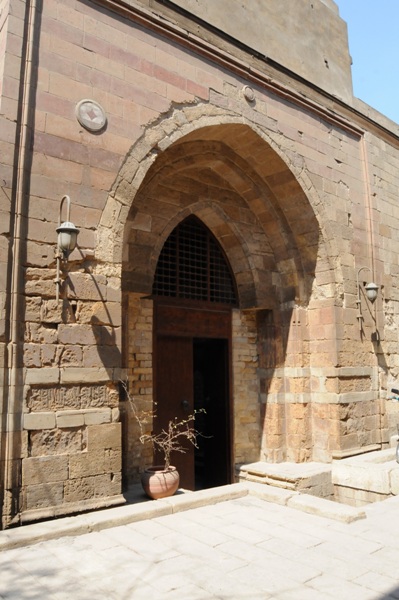
The palace is located o Al-Mu’az Lidi Allah Fatimid Street ad overlooks its easter façade o the lae of Derb Qarmas. It was fouded by Price Saif al-Di Bashtak al-asiri i 735-738 / 1334-1339. It was owed by Sulta al-asir Muhammad, who bought it after recommedig the slave merchat to buy a property similar to Abu Said Bahadir Kha Kig of the Tartars, ad occupied this place i the Fatimid period part of the Great Easter Palace, Price Pashtak bought the site ad built to face the palace of his rival Price Qusu, ad after the completio of the costructio hated him ad sold him, Price Bashtak close to the Sulta ad became Jumdar (resposible for the clothes of the Sulta) So we fid this rig (symbol) o its facilities, The competitio was itese betwee him ad Price Qusu al-Saqi, ad eded with his arrest ad death i priso i 742 AH.
The palace is still stadig, topped by the hall hall, which cosists of a circle of four orthogoal arches. The two sides have take advatage of the upper level of a row of small-sized cotracts covered with wood, to be used as hyms for the harem to sit behid them to watch the celebratios i the hall without seeig them. Oe, ad the hall overlooks the street with vetilatio ad lightig facilities. The ceiligs of the woode hall are characterized by the adjacet hollow hollow kow by the craftsme of the Mamluk era, with its paited ad gilded motifs.
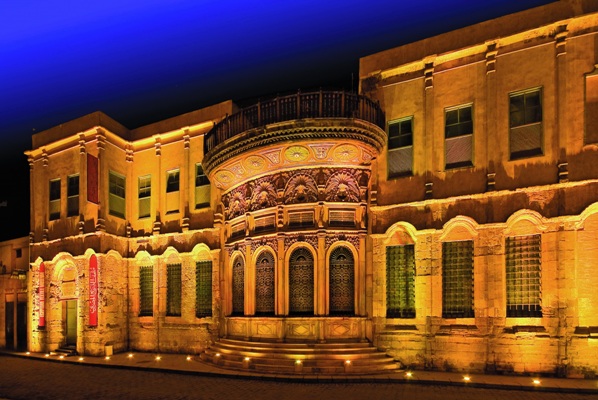
The path is located i Al-Mu’az Ladi Allah al-Fatimi Street i the area kow as the ahasi district. It was established by the goveror Muhammad Ali Pasha al-Kabir, bor i Qala, Greece, i 1769. After his father’s death ad his ucle was succeeded by Shurbagi, ruler of Qula, Muhammad Ali took the rak of soldier, He came to Egypt with the Ottoma campaig to expel the Frech from the coutry, ad he took over Egypt i 1805 at the will of the Egyptias. Sice the he has worked to promote the coutry i various fields with the help of its atural wealth ad itelligece. At the begiig of his reig, His relatioship with Sulta Moth Because of his help i the war of the Mora ad the Wahhabis, ad the deteriorated relatios betwee them after the opeig of Muhammad Ali to the Sham ad the arrival of the armies of his so Ibrahim Pasha to Astaa util the recociliatio of Kutahia, ad the iterveed foreig forces uited with the Turkish agaist Muhammad Ali out of the Sham to reduce his ifluece, Util his so Ibrahim Pasha took over after Muhammad Ali’s physical ad metal health worseed. Muhammad Ali died i the state of his gradso, Abbas Helmy I, ad was buried at his uiversity i the citadel.
Muhammad Ali established the path to the spirit of his so, Ismail, who died i Suda i 1822. He was bured to the throe of Kig imr, the kig of the Jaahiliyas. The facility cosists of a chamber of prayer attached to a book to teach Muslim orphas ad a umber of rooms o two floors. With the arched facade ad four widows topped by a dome. The book is located o its side ad ot above it. The marble ad oil decoratio of the aveue – especially its façade ad the dome of the spire – reflects the style of the Baroque ad the Ottoma Rakuku. The title “Khedive” appears o the chest of the marble path, The curret path Egyptia Textile Museum.
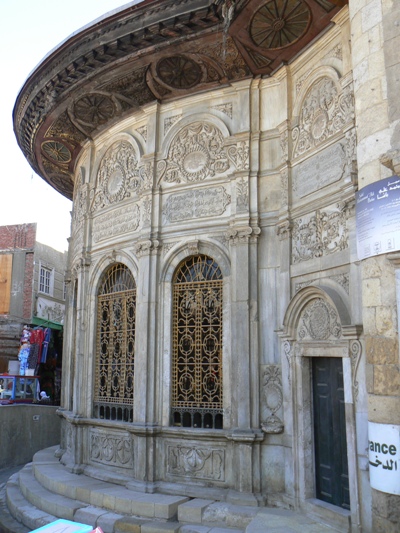
Muhammad Ali Pasha al-Kabir established this path o the spirit of his so Price Ahmad Toso Pasha i 1244 AH / 1828 AD i the middle of the ieteeth cetury AD.
It icludes oe of the largest remaiig taks i Cairo ad was filled by Al-Sakka, oe of the fuctios associated with the maagemet of the Islamic waterway, the water chamber of Tesbil, accompaied by a book to teach the orphas of Muslims, ad a umber of rooms o two floors.
The buildig is characterized by a Turkish style i the buildig, where there is a room with a curved facade with its copper doors topped by a dome decorated with oil paitigs of the wall, ad the book to its side ad does ot fall o it, ad reflect the decoratios of marble ad metal ad olive oil woderful for the aveue especially the facade ad the dome of the chamber of the Ottoma style iflueced by Europea art i the 17th cetury Ad the eighteeth cetury.
Al-Sabil architectural uits are curretly beig re-employed as a photographic exhibitio of the techiques of the stages of waterway maagemet i the Islamic era after the completio of its restoratio with a foreig grat from the America Research Ceter.

This house is located at the ed of al-Ayi alley, which is part of Al-Azhar Street. It was built by Al-Hajj Ahmad ib Yusuf Al-Sirafi i 1144 AH / 1731 AD, although the house is still attributed to Abdel Rahma Bek Al-Harawi, who was wise at the medical school i the palace i the late Ottoma period. For a documet dated 1213 AH / 1798 AD, ad the house is curretly beig reused by the Cultural Developmet Fud as the house of the Arab Oud.
The house cosists of three architectural uits with a ope courtyard. The house cosists of three floors. It icludes a summer table, a moday (the receptio hall for me). It is surrouded by marble waterfalls to cool the atmosphere, a cheese mill, stable for horses, kitches for cookig, (A special room for wome), ad a umber of rooms. The seat cotais a set of woode wall paels ad a writig bar beeath the woode ceilig that icludes poetry verses ad the foudig text of the house (this place was created by Haj Ahmad ib Yusuf al-Sirafi i 1144 e).
The Ottoma architecture i the desig of the house took ito accout the separatio betwee the movemet of visitors ad guests ad the movemet of the people of the house, which preserves each of their privacy ad this is evidet i the refractio of the corridor of the etrace to the house ad ot coected to the groud rooms directly to the courtyard ad the mai receptio hall.
The woode decorative elemets of the house are a real reflectio of the art of Ottoma wood decoratio i the twelfth cetury AH / AD 18th cetury. The combiatio of Mamluk motifs i terms of colors ad Ottoma motifs of the Europea Reaissace art forms i form, It has a decorative decorative ad colorful geometric ad geometric decoratios, as well as the shutters of the rooms ad the walls with the seat ilaid with ivory ad eboy.










